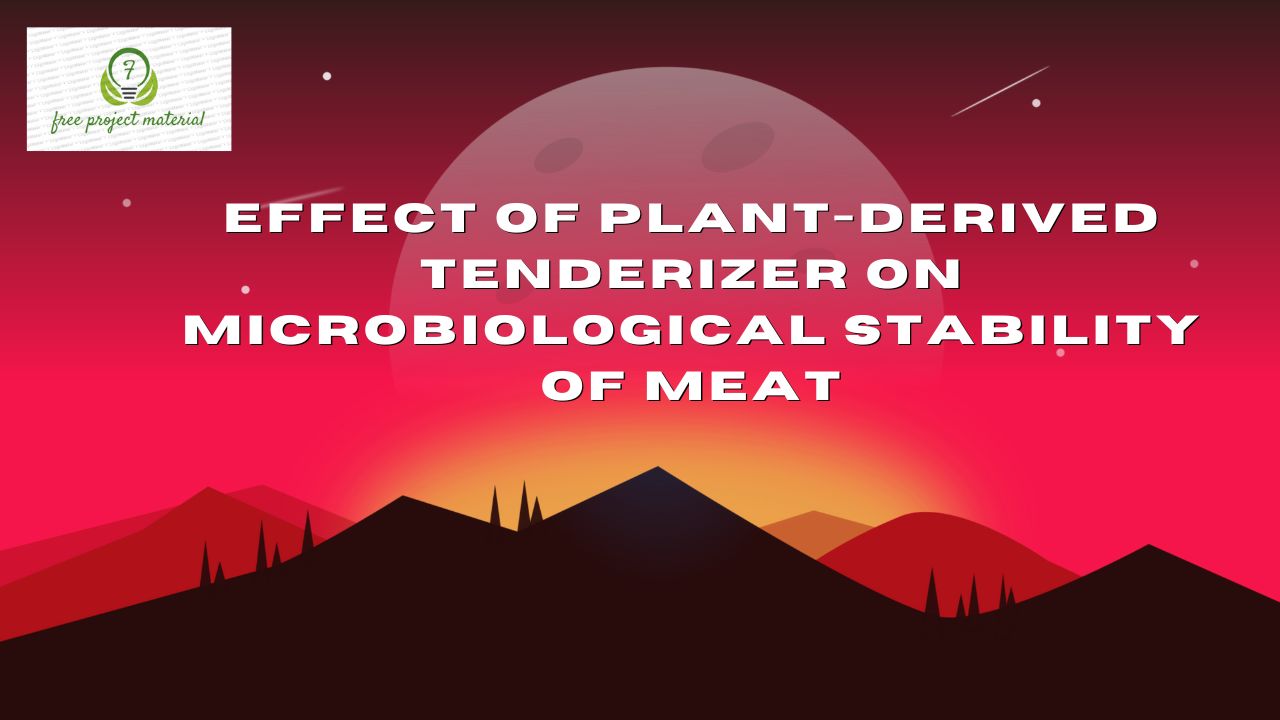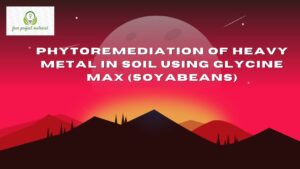ABSTRACT
Unripe pawpaw which contains papain enzyme was used as a source of plant-derived tenderizer on meat samples and the microbiological stability of the treated meat studied. The raw meat had a bacterial count of 7.2×106, the cooked meat without paw-paw treatment had a bacterial count of 5.7×106 while the paw-paw treated meat had a bacterial count of 4.2 x 106 cfu/g .The fungal count ranged from 2.7 x 104 cfu/g to 2.1 x 104 cfu/g. The raw meat had a fungal count of 2.7 x 104 cfu/g, cooked meat without unripe pawpaw had a fungal count of 2.2 x 104 cfu/g, while cooked meat with pawpaw had a fungal count of 2.1 x 104 cfu/g. Bacteria present were Leuconostoc sp., Listeria sp., Aeromonas sp., Lactobacillus sp., Staphylococcus sp. and Pseudomonas sp. with Lactobacillus sp. having the highest number of occurrence while Listeria sp. had the least number of occurrence. Aspergillus sp. had the highest fungal count while Cladosporium sp. had the least fungal count. Sensory evaluation was done by 10 panel judges to analyze for texture, taste, flavor and overall acceptability using a 9 point Hedonic scale. There was a positive significant difference in terms of texture (t-cal6.56>t-tab 2.262) and the flavor (t-cal14.97>t-tab2.262). There was also a significant difference in taste (t-cal2.352> t-tab2.262) and overall acceptability of the sample (t-cal2.352>t-tab 2.262) respectively. From the sensory evaluation on texture, it showed that the meat was tender by the pawpaw which contains the papain enzyme because the result showed that t-cal (6.56) for texture was greater than t-tab (2.262). The 9-point Hedonic Scale of Sensory evaluation of the pawpaw treated meat shows that the need to use natural tenderizers to tenderize meat and reduce the microbial load is highly recommended as it improves the palatability, the quality of the meat and tenderizes the meat.
TABLE OF CONTENTS
Contents Pages
Title page – – – – – – – – – i
Certification – – – – – – – – ii
Dedication – – – – – – – – – iii
Acknowledgement – – – – – – – – iv
Abstract – – – – – – – – – v
List of Tables – – – – – – – – vi
Table of contents – – – – – – – – vii-xii
CHAPTER ONE: INTRODUCTION
1.1 Background of the study- – – – – – – 1-3
1.2 Statement of the problem – – – – – – 3-5
1.3 Aim and objective – – – – – – – 5
1.3.1 Major Aim – – – – – – – – 5
1.3.2 Specific Objective – – – – – – – 5
1.4 Benefits of the study – – – – – – 5-6
1.5 Significance of the Study – – – – – – 6-7
1.6 Scope and limitation of the study- – – – – 7
CHAPTER TWO: LITERATURE REVIEW
2.1 Meat products – – – – – – – 8
2.2 Meat spoilage – – – – – – – 9-11
2.3 Shelf life and microbial spoilage of meat – – – 11-12
2.4 Causes of meat spoilage – – – – – – 12-13
2.4.1 Microbial spoilage – – – – – – – 13-14
2.4.2 Lipid oxidation – – – – – – – 14-16
2.4.3 Autolytic enzymatic spoilage – – – – – 16-17
2.5 Microorganisms responsible for meat spoilage – – 17
2.5.1 Salmonella sp. – – – – – – – 17-18
2.5.2 Clostridium pefringens – – – – – – 18-19
2.5.3 Escherichia coli 0157 – – – – – – 19-20
2.5.4 Listeria monocytogenes – – – – – – 20-21
2.6 Spoilage organisms – – – – – – 21-22
2.7 Biochemical events that lead to rigor mortis – – – 22-24
2.8 Meat composition and deterioration – – – – 24-25
2.8.1 Lipid oxidation – – – – – – – 25-26
2.7.2 Oxidation of proteins and pigments – – – – 26-27
2.7.3 Microbial deterioration – – – – – – 27-28
2.9 Meat tenderization with plant proteases – – – 28-31
2.10 Types of plant-base meat tenderization – – – 31
2.10.1 Papain – – – – – – – – 31-32
2.10.2 Bromelain – – – – – – – – 32-33
2.10.3 Ficin and actinidin – – – – – – 33-34
2.10.4 Calpain – – – – – – – – 34-35
2.10.5 Bacterial enzymes – – – – – – 36-37
2.11 Vegetative extracts as tenderness in meat and meat
Products – – – – – – – – 37-39
2.12 Factors affecting meat tenderness – – – – 39-40
2.12.1 Ageing tenderization – – – – – – 40
2.12.2 Calpain system and tenderizing mechanism – – – 41
2.12.3 Protein biomakers characteristics postmortem tenderness 41-42
2.13 Postmortem techniques to improve meat tenderness various
techniques used in meat tenderness – – – – 42
2.13.1 Enzymatic techniques – – – – – – 41-44
2.13.2 Chemical techniques – – – – – – 44-48
2.13.3 Traditional physical techniques – – – – 48-49
2.14 Potential mechanical techniques – – – – 49-53
CHAPTER THREE: MATERIALS AND METHODS
3.1 Sample collection – – – – – – – 54
3.2 Sterilization of glass wares and media – – – – 54-55
3.3 Sample preparation – – – – – – 55
3.4 Sensory evaluation – – – – – – 55-57
3.5 Microbiological analysis of samples – – – – 57
3.4.1 Serial Dilution of the sample – – – – – 57
3.4.2 Cultivation of microorganism – – – – – 58
3.4.3 Enumeration of Bacterial Isolates – – – – 58
3.4.4 Purification of Bacterial Isolates – – – – 59
3.4.5 Preparation of Stock Culture – – – – – 59-60
3.4.5 Characterization and Identification of bacterial Isolates – 60
3.5 Fungal analysis – – – – – – – 60
3.5.1 Macro-Examination of fungal – – – – – 60
3.5.2 Micro-Examination of fungal – – – – – 60-61
CHAPTER FOUR: RESULTS AND DISCUSSION
4.1 Results – – – – – – – – 62-70
4.2 Discussion – – – – – – – – 71-82
CHAPTER FIVE: SUMMARY, CONCLUSION AND RECOMMENDATION
5.1 Summary- – – – – – – – – 83
5.2 Conclusion- – – – – – – – 83-84
5.3 Recommendation- – – – – – – 84
References
Appendix
LIST OF TABLES
Tables Title Pages
Table 4.1: Heterotrophic bacterial colony counts – – – 65
Table 4.2: Cultural, microscopical and biochemical characterization
of the bacterial isolates – – – – – 66
Table 4.3: Frequency and percentage occurrence of the bacteria
isolates – – – – – – – 67
Table 4.4: Heterotrophic Fungal Colony Counts – – – 68
Table 4 5: Frequency and Percentage Occurrence of the
Bacterial Isolates – – – – – – – 69
Table 4 6: Frequency and percentage distribution of the fungi – 70
CHAPTER ONE: INTRODUCTION
1.1 Background of the Study
Tenderness is a crucial palatable quality affecting consumer`s preference to meat products, and the upgrading of low-value meat with guaranteed tenderness will favor products with higher price (Zhu et al., 2019).
Particularly, from the perspective of dietary evaluation, products displaying harder chewiness deter the elderly from consuming. Thus, meat scientists have been committed to improving meat tenderness in order to increase the repeat purchase desire of consumers and to produce better sensorial acceptable meat products (Li et al., 2012). The up-regulation of pre-slaughter tenderness is affected by rearing practices (breed, sex, genotype, nutrition and age), and also by muscle structure and composition (Devlin et al., 2017). This study mainly focuses on the postmortem tenderization based on the perspective of meat processing. Typically, the fragmentation of muscle structural and associated proteins (e.g., myosin, actin, collagen and elastin) mediated by endogenous protease (e.g., calpain), as well as the continuous degradation of cytoskeleton proteins and the energy metabolism can increase postmortem tenderness (Koohmaraie and Geesink, 2016).
Moreover, ageing tenderization is widely used in the meat industry, and post mortem ageing is a value added process of obtaining better tenderness and flavor (Picard et al., 2014).
Comprehensive understanding of the relationship between endogenous proteases and postmortem ageing will render people to design targeted interventions for better tenderness. It has to be mentioned that applying proteomics to identify protein biomarkers characterizing tenderness is conductive to deeply understanding the complex biological pathways and non-destructively predicting the tenderness development. Nevertheless, high-quality meat tenderness based on ageing tenderization is often at the expense of sufficient time, larger storage space and higher energy consumption. The drawbacks of ageing tenderization require the use of other tenderizing techniques to meet the demand (Picard et al., 2014).
Different feeding diets and farming management interventions of animals are commonly used to modify preslaughter muscle tenderness, which are systematic and time-consuming process (Cao et al., 2014). By contrast, different types of tenderizing techniques are developed for postmortem meat that are short-term and effectively produce high-quality commercial products. Current techniques for postmortem tenderization can be classified into enzymatic, chemical, physical and combined categories (Al-Hilphy et al., 2020). Of them, some techniques cannot achieve the similar tenderizing trend, which may be ascribed to the difference of materials (e.g., feeding conditions and slaughtered status) and equipment performance (Arroyo et al., 2015). Moreover, the implementation of these interventions in meat industry is limited by the willingness of operators, technological aspects or input costs, and actual. Hence, understanding how each technology induces the improved tenderness of postmortem meat will favor the scientists and manufacturers to produce more guaranteed tender meat benefits (Bhat et al., 2019).
1.2 STATEMENT OF THE PROBLEM
Meat is considered a major source of protein for human consumption due to its availability and nutritional content despite the high cost presently. Despite its nutritional and health benefit, meat consumption has become a major problem to some group of people, mostly the elderly and children due to its hardness and toughness while chewing. This characteristic has highly affected the quest/desire for meat purchase and consumption and the use of hazardous product in tenderizing of meat which further affect the level of sales, leading to nutritional imbalance of humans mostly the elderly and children who are highly in need of these nutrients for proper growth and development. In African Cuisines, local materials are used in tenderization of meat. Some of these materials are plant/vegetable sources which passes some bioactive compounds to make meat tender when assessed when chewing. It is the proteolytic effect of the compounds that lead to tenderization of the meat. Sources of these proteolytic enzymes include Onions, pawpaw, and pineapple. However, some metals and salts are also used in meat softening but could have some hazards. Most food vendors have resulted to the use of chemicals and metals such as paracetamol, panadol tablets, nails etc. in the softening of meat which posses health challenges, irrespective of its low doses or concentration.
Therefore, this study is done to address, a simple more common, available and non-hazardous means of tenderizing of meat to improve its consumption, palatability of meat for human consumption devoid of health risk and also prolonging shelf life and tenderization.
1.3 AIM AND OBJECTIVES
1.3.1 Major Aim
The major aim of this study is to assess the effect of plant-derived tenderizer on the microbiological stability of meat.
1.3.2 Specific Objectives
- To Assess tenderizing capability of pawpaw as plant derived tenderizer.
- To assess the microbial load associated with plant-derived tenderized meat.
- To proffer recommendation based on the results of the study.
1.4 BENEFITS OF THE STUDY
The study highlighted the effect of paw-paw fruit as source of papain in tenderizing meat products as well as on the microbial load and associated microorganisms present on the meat when compared with untenderized meat. The research will be of benefits to meat based products companies, eateries, nutritionists and restaurants etc. on the importance of plant product in tenderizing of meat products, making it more stable and suitable for human consumption.
1.5 SIGNIFICANCE OF THE STUDY
The study is significant to various field of life including individuals as the results will reveal the importance of plant derived tenderizers on meat instead of the usual nails and paracetamols.
This study is significant to meat based food companies, in educating the company on the used and effect of plant derived tenderizer in tenderizing meat, palatability and reduction in its microbial load thereby boosting its palatability, reducing foodborne illness which will encourage high patronage. Nutritionists will also gain from this study by employing the use of plants material in softening meat for easy mastication, digestion and assimilation of desired and required nutrients. This study will add knowledge to research on the use of plant source tenderizer (papain) in the tenderization of meat.
This study is also significant to the general public, homes, eateries, restaurants etc. as the results will encourage them on the use of plant derived products in improving the tenderness of meat. Finally, this study is significant to body of research as it will add to the already researched material on the effect of plant derived products on meat tenderization. The study will add knowledge to research on the use of plant sources tenderizer (papain) in the tenderization of meat.
1.6 SCOPE AND LIMITATION OF THE STUDY
The scope and limitation of the study is limited to the effect of plant-derived tenderizer (papain) on meat products and the effect on plant-based tenderizers on the associated microorganisms.
This study is limited to the above mentioned parameters due to time and financial constraint during the research period.


